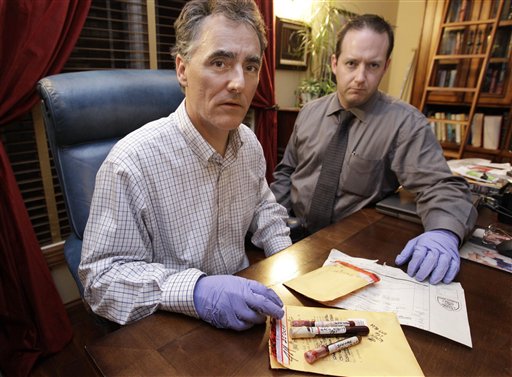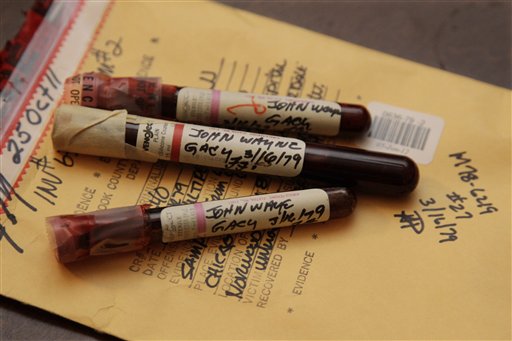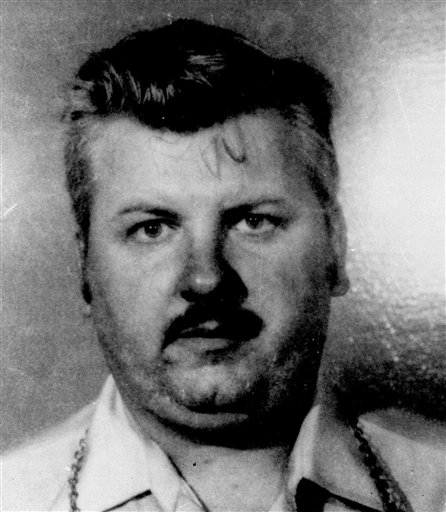CHICAGO — Detectives have long wondered what secrets serial killer John Wayne Gacy and other condemned murderers took to the grave when they were executed — mostly whether they had other unknown victims.
Now, in a game of scientific catch-up, the Cook County Sheriff’s Department is trying to be creative: They’ve created DNA profiles of Gacy and others and figured out they could get the executed men entered in a national database shared with other law enforcement agencies because the murderers were technically listed as homicide victims when they were put to death by the state.
The department’s hope is to find matches of DNA evidence from blood, semen or strands of hair, or skin under the fingernails of victims that link the long-dead killers to the coldest of cold cases. And they’re hoping to prompt authorities in other states to submit the DNA of their own executed inmates or from decades-old crime scenes.
“You just know some of these guys did other murders” that were never solved, said Jason Moran, the sheriffs’ detective leading the effort, noting that some of the executed killers ranged all over the country before the convictions that put them behind bars for the last time.
The Illinois testing, which began during the summer, is the latest chapter in a story that began when Sheriff Tom Dart exhumed the remains of unknown victims of Gacy to create DNA profiles that could be compared with the DNA of people whose loved ones went missing in the 1970s, when Gacy was killing young men.
That effort, which led to the identification of one Gacy victim, caused Dart to wonder if the technology could help answer a question that has been out there for decades: Did Gacy kill anyone besides those young men whose bodies were stashed under his house or tossed in a river?
“He traveled a lot,” Moran said of Gacy. “Even though we don’t have any information he committed crimes elsewhere, the sheriff asked if you could put it past such an evil person.”
After unexpectedly finding three vials of Gacy’s blood stored with other Gacy evidence, Moran learned the state would only accept the blood in the crime database if it came from a coroner or medical examiner.
Moran thought he was out of luck. But then Will County Coroner Patrick O’Neil surprised him with this revelation: In his office freezer were blood samples from Gacy and at least three other executed inmates. The reason they were there is because after the death penalty was reinstated in Illinois in the 1970s, executions were carried out in Will County — all between 1990 and 1999, a year before then-Gov. George Ryan established a moratorium on the death penalty. So it was O’Neil’s office that conducted the autopsies and collected the blood samples.
But there was bigger obstacle.
While the state does send to the FBI’s Combined DNA Index System the profiles of homicide victims no matter when they were killed, it will only send the profiles of known felons if they were convicted since a new state law was enacted about a decade ago that allowed them to be included, Moran said.
That meant the profile of Gacy, who received a lethal injection in 1994, and the profiles of other executed inmates could not qualify for the database under the felon provision. They could, however, qualify as people who died by homicide.
“They’re homicides because the state intended to take the inmate’s life,” O’Neil said.
Last year, authorities in Florida created a DNA profile from the blood of executed serial killer Ted Bundy in an attempt to link him to other murders. But officials there, where the law allows profiles of convicted felons be uploaded into the database as well as the phase-in of profiles of people arrested on felony charges, don’t know of any law enforcement agency reaching back into history the way Cook County’s sheriff’s office is.
“We haven’t had any initiative where we are going back to executed offenders and asking for their samples,” said David Coffman, director of Florida Department of Law Enforcement’s laboratory system. “I think it’s an innovative approach.”
O’Neil said he is still looking for blood samples of the rest of the 12 condemned inmates executed between 1977 when Illinois reinstated the death penalty and 2000 when then-Gov. George Ryan established a moratorium. So far, DNA profiles have been done on the blood of Gacy and two others; the profile of the fourth inmate has not yet been done.
Among the other executed inmates whose blood was submitted for testing was Lloyd Wayne Hampton, a drifter executed in 1998 for his crimes. Not only did Hampton’s long list of crimes include crimes outside the state — one conviction was for the torture of a woman in California — but shortly before he was put to death, he claimed to have committed other murders but never provided details.
So far, no computer hits have linked Gacy or the others to any other crimes. But Moran and O’Neil suspect there are investigators who are holding DNA evidence that could help solve them.
That is exactly what happened during the investigation into the 1993 slayings of seven people at a suburban Chicago restaurant, during which an evidence technician collected a half-eaten chicken dinner even though there was no way to test it for DNA at the time.
When the technology did become available, the dinner was tested and it revealed the identity of one of two men ultimately convicted in the slayings.
Moran says he wants investigators in other states to know that Gacy’s blood is now open for analysis in their unsolved murders. He hopes those jurisdictions will, in turn, submit DNA profiles of their own executed inmates.
“That is part of the DNA system that’s not being tapped into,” he said.
Send questions/comments to the editors.





Success. Please wait for the page to reload. If the page does not reload within 5 seconds, please refresh the page.
Enter your email and password to access comments.
Hi, to comment on stories you must . This profile is in addition to your subscription and website login.
Already have a commenting profile? .
Invalid username/password.
Please check your email to confirm and complete your registration.
Only subscribers are eligible to post comments. Please subscribe or login first for digital access. Here’s why.
Use the form below to reset your password. When you've submitted your account email, we will send an email with a reset code.